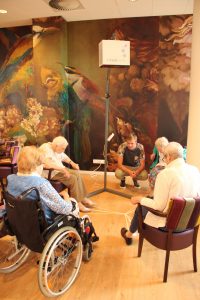 Tover Tapijt
Tover Tapijt
Stimulating elderly in care homes to move using Tovertafel games
As the pressure on elderly care is strong, preventive policy for health care is therefore essential. The goal of prevention for elderly is to keep older adults healthy, autonomous and independent as long as possible, even when they already need daily care. A preventive measure which is increasingly gaining popularity over the past few years is physical exercising. Physical activity can help reduce progression of diseases, delays emerging disabilities, has a positive influence on cognitive functioning, increases emotional well-being, and reduces the risk of loss of independence. This results in an overall better quality of life in nursing homes. Unfortunately, as the required level of care needed for elderly people in nursing homes is relatively high compared to those who could still live at home, preventive exercising is not always seen as essential in the residential setting yet. Moreover, due to factors as pain, changing attitude, fear of falling, lack of availability and care staff taking over activities, inactivity problem in nursing homes is increasing. Different types of preventive physical activities, motivators, barriers and role of stakeholders are explored during the context research phase of the project.
Exergames – interactive computer games which require physical activity in order to play – were found to be effective means to stimulate elderly people in nursing home to become physically active. Well-designed games can increase intrinsic motivation as they stimulate discovery, enable the player to intuitively able operate tasks, fit interests of the player, enable interaction with others, and provide an appropriate level of challenge. Related to motivation of playing (computer) games and to exercise adherence, well-designed exergames could get the users into a state of flow. Furthermore, context research revealed that older adults are motivated by social interactions and group play, so multi-player exergames can be positively influencing the play experience and adherence.
Although several existing exergames are specifically for the elderly target group, opportunities were found to design an exergame based on Tovertafel technology. From the observations and interviews during the context research, it became clear that one of the most valuable things for elderly people in terms of physical well-being is to maintain as much functional mobility as possible. Functional mobility refers to a person’s ability to carry his own weight while standing, make transfers and move independently in order to perform personal care and Activities of Daily Living. Based on context research insights, an exergame focusing on lower extremity activity was designed with the following interaction qualities in mind: immersive, experience-focused, social, skill-independent, pleasurable. The ideation phase was focused on generating and testing inspiring game ideas which could be further developed by going through a few quick iterations. The final result of the ideation phase was a single evaluated game concept of a music game, which had most potential to stimulate players to maintain functional mobility in an enjoyable way, while meeting the design goal, interaction vision and requirements. In collaboration with physio therapists, programmers, users and music-therapist the exergame concept has been refined in the conceptualization phase of the project. Parts of this concept have been developed into interactive prototypes for user testing purposes. Although game design should be seen as a coherent whole, the serious game design framework of (Mitgutsch and Alvarado, 2012) offered a basis to structure all game elements (framing, narrative, content, aesthetics, mechanics) in relation to the game purpose of stimulating elderly people to become physically active in order to maintain mobility. This framework was used to iterate on all game elements and to guide the play-tests in the evaluation phase. The final concept can be described as a rhythm game in which players need to stamp on the glowing cues, in order to turn on an instrument tracks of the song. The players cooperate to hear all instruments, thus when all play well, the complete song is the ultimate result. The difficulty of the glowing patterns(which are following the beat) is dynamically adjusted based on the performance of the individual player. This challenges all players at their own level of physical and cognitive abilities. The evaluation of the design goal and interaction vision showed that the game stimulates elderly people to move their legs, while all interaction qualities are found in the play experience.
Nina van Adrichem
Van der Cammen, T.J.M., Goossens, R.H.M.
master thesis, August, 2016
This project is conducted at Active Cues


